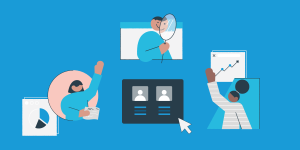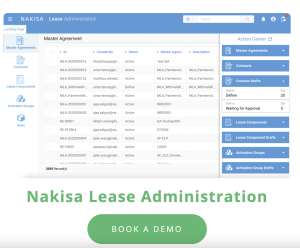We’re living in the golden age of data. What was once the domain of a handful of big companies is now accessible to even the smallest organization—provided they know what to do with it. “While we have all this data, and it’s becoming more influential than ever, there’s still a big problem at hand: Most of us are not very good at interpreting and making sense of it,” noted the Harvard Business Review last year.
When you do make sense of it, however, it’s a boon to your organization—especially in terms of strategic HR. Data is crucial to identify and assess emerging trends in order to develop them into business opportunities. And it’s an essential tool to make sure your HR strategies are well aligned with your organization’s goal.
Gathering all the data necessary to do that is now easier than ever. But what then? In this interview, Sachin Sandeep Vendat, Solutions Engineer at Nakisa, explains how to ensure the quality of the data you are collecting, what you can do with it and how to make sure your data is secure.
Why collect data?
It’s a way to make informed decisions—a way to measure the effectiveness of a strategy implementation. Without measuring the results it wouldn’t be possible to do that. In order to find the root cause of an issue, analysis of data is very much important.
But for good analysis you need to make sure your data is accurate. According to research by Gartner, bad data costs the US economy $3 trillion per year, and the average company is spending $9.7 and $14.2 million every year as a consequence of poor quality data. So how do you make sure the data you’re getting is correct?
I can give you a specific example with Nakisa’s org design and workforce analytics product, Nakisa Hanelly. We have a tool called Insights, which gives you the ability to pinpoint what percentage of your data is error free. It gives a clear number and transparency to the quality of your data.
Beyond quality, there’s also the issue of quantity. There is just so much data being collected. Is that what “big data” means? And what does big data mean for organizations?
Big data is large in volume, it has a variety of sources and the velocity at which the data grows is much higher than how normal data works. Before 2000, data was collected from a minimum number of sources, like business transaction data, which is just structured data. Now you have unstructured data like what’s being communicated in an email or over a chat platform. In recent years, the data that is being collected in two days is the same as the data we’ve collected over many decades in the past.
And how can an organization cope with all that data?
When the amount of data increases, the processing capacity needs to improve. That’s something that has emerged in recent years with quantum computing, machine learning, artificial intelligence. These are things that have improved our ability to process large amounts of data.
So how are most organizations doing when it comes to that?
A lot of large organizations have a number of data analytics teams in place to mine their data. But a lot of smaller organizations haven’t caught up yet. Maybe they are happy with the tools they have and they haven’t ventured into big data for a number of reasons. But when you invest in big data you usually see a return.

The shock of the pandemic and its associated economic downturn have forced a lot of companies to reorganize, whether that has meant transition to work-from-home or reshuffling operations in different regions. How can a better understanding of data help a company reorganize?
During a scenario like a pandemic or recession that requires quick reorganization, companies have to be agile. If they are not, they will be pushed out of the market. In order to respond to major changes, companies will typically take part in an org design exercise and try to find a target operating model. The org design exercise can be carried out by using the STAR framework developed Jay Galbraith. What is the new direction of company? What are the new reporting relationships? What information flows, processes and workflows are required? These are some of the important questions that need to be answered.
And where does data come into that?
Just before the design process, we need to analyze the current organization. That’s where data is very important. In order to carry out the org design exercise, we need data to assess the health of the current org by department, team, division, demographic, etc.
Once you come up with the target operating model, you feed it into an org transformation tool and experiment with various scenarios—merge departments, move people around—to see if the final organization meets your goals. If you want to reduce the workforce by 20 percent, you define that direction in the target model, feed it into a transformation tool, and take a snapshot of the data. Then you can feed that data into a financial planning or analytics tool. Without data, the whole process is impossible.
When you’re collecting and analyzing all this data, what’s the advantage of a solution like Hanelly?
There are tons of other tools available on the market, but the issue is that when it comes to mining data and getting meaningful information out of them, you need a lot of expertise. With Hanelly, we have more than 240 out-of-the-box analytics that can be configured without in-depth knowledge. You simply collect your data and with the click of a button you get 240 meaningful charts.
Can you give us an example?
In April 2019, Quebec introduced the Pay Equity Act, requiring companies to come up with a lot of data and publish reports for the government. Some of the HR systems you see on the market don’t have the capability to do that. So companies need a system like Hanelly to help deal with these new regulatory requirements. That is an area where Hanelly is able to mine data better and provide what companies are asking for.
What about security?
Information like financial or payment data, intellectual property, and sensitive personal information of employees are the kind of data that hackers are after and it is imperative that data security processes and technologies are put in place to protect it.
It is also important to adhere to the various international privacy laws and data protection requirements such as GDPR, PIPEDA, and so on. By not adhering to these regulations, companies will be subjected to huge penalties and lawsuits from their customers.
How does Hanelly help with that?
Nakisa Hanelly has several security related functionalities that help protect data from employees of the organization who do not have access. It is important that sensitive employee data such as salary information and succession planning information must be available only to authorized personnel. We make this possible by using the following functionalities: Role-based security, matrix security and enhanced security functions.







